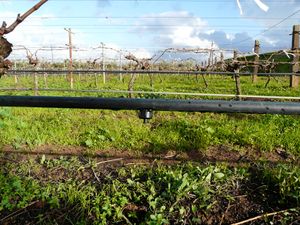Knowledge fuels change
For over a decade, Energypedia has shared free, reliable energy expertise with the world.
We’re now facing a serious funding gap.
Help keep this platform alive — your donation, big or small, truly matters!
Thank you for your support
Difference between revisions of "SPIS Toolbox - Irrigation System"
***** (***** | *****) m |
***** (***** | *****) m |
||
| Line 1: | Line 1: | ||
| − | {{SPIS Banner}} | + | {{SPIS Banner}}{{Back to Get Informed}} |
=== '''<span style="color:#879637;">Irrigation System</span>''' === | === '''<span style="color:#879637;">Irrigation System</span>''' === | ||
Revision as of 12:06, 9 June 2017

Introduction
Do want to know all about SPIS – Solar Powered Irrigation System : Please go to the newly launched standalone Solar Powered Irrigation Systems (SPIS) website (www.spis-toolbox.org) , featuring three SPIS toolbox:
- Toolbox for beginners,
- Toolbox for farmers (new SPIS Web based App – to calculate design of the pumps),
- the Toolbox for experts - the updated version - Version 6
and additional resources (Publication about SPIS).
The Toolbox on Solar Powered Irrigation Systems (SPIS) is designed to enable advisors, service providers and practitioners in the field of solar irrigation to provide broad hands-on guidance to end-users, policy-makers and financiers. Risks related to system efficiency, financial viability and the unsustainable use of water resources can thus be minimized. The Toolbox comprises informative modules supplemented with user-friendly software tools (calculations sheets, checklists, guidelines). read more
Modules and tools touch upon:
- assessing the water requirements,
- comparing the financial viability,
- determining farm profitability and payback of investment in SPIS,
- sustainably design and maintain a SPIS,
- highlight critical workmanship quality aspects,
- and many more.

style="width: 160px; background-color: rgb(111, 142, 43);" | ►Back to the Module Page
Irrigation System
Water is the most important input required for plant growth in agriculture production. Irrigation is the controlled application of water through man-made systems to supply water requirements of plants not satisfied by rainfall alone. Various methods can be used for irrigation (starting from simply watering plants with a pot or a bucket). The choice of a particular irrigation system mainly depends on the crops to be irrigated, the underlying water availability, irrigation water requirements and energy supply as well as the financial capacity of the farm household. Solar pumps pump up water to the farm, from where it can be collected for further distribution by hand. Alternatively, it can be pumped directly to the field through a system of canals (surface irrigation) or pipes (sprinkler and drip irrigation). In principle, solar pumps can be used for supplying water to any kind of irrigation system. The size (and cost) of the PV generator is mainly determined by the water and pressure requirements of the irrigation scheme. However, it is important to consider that SPIS are relatively expensive, requiring producers to grow high-value crops to guarantee its financial viability. In addition, water savings will have a positive influence on the investment costs of the solar pumping system and the environment.
Surface irrigation systems are not always suitable for high-value crop production and they are far from being water-efficient. However, SPIS with surface irrigation systems are widely used as they do not require the producer to adopt a new irrigation method. SPIS are seldom combined with sprinkler irrigation because sprinkler irrigation requires relatively high water pressures to operate, which demands expensive PV generators.
Water-saving irrigation technologies working at comparably low operating pressures are the preferred option in connection with PV pumping systems.
Drip irrigation systems normally operate at high pressures of 1–10 bar. Fortunately, the technology has been adapted to cater for low pressures and a more simplified operation. These low-pressure drip irrigation systems can give 80% uniform water application even from a few meters pressure. The performance is very much dependent of the pressure, the size and shape of the field being irrigated. Solar-powered drip irrigation is the “marriage” of two systems that go very well together. Drip irrigation is ideal for high-value crop production such as vegetables and fruits, and due to its high efficiency the solar pump can be quite conservatively sized.
Suitability of irrigation methods to PV pumping
|
Distribution method |
Typical water application efficiency |
Typical head |
Suitability for use with PV pumps |
|
Flood irrigation |
40–50% |
0.5 m |
barely cost-efficient |
|
Open canals |
50–60% |
0.5–1 m |
depends on local conditions |
|
Sprinkler |
70–80% |
10–20 m |
No |
|
Low pressure drip irrigation |
80% |
1–10 m |
Yes |
|
High pressure drip irrigation |
85–95 % |
10–100m |
No |




















